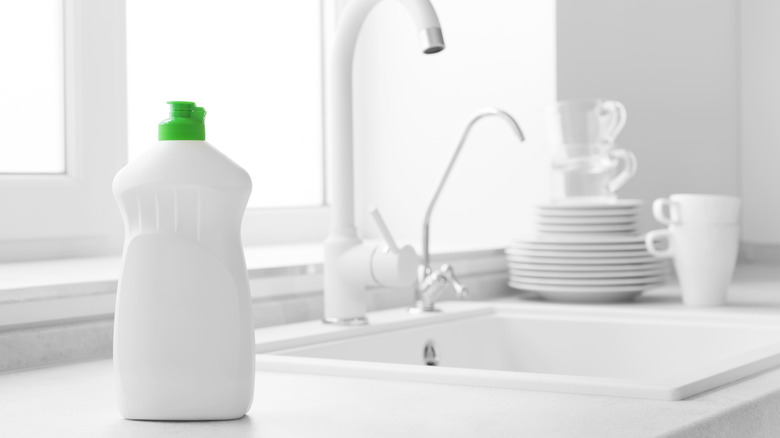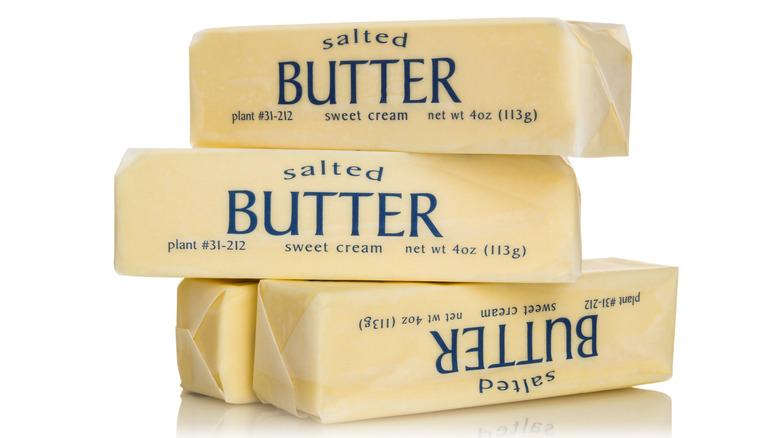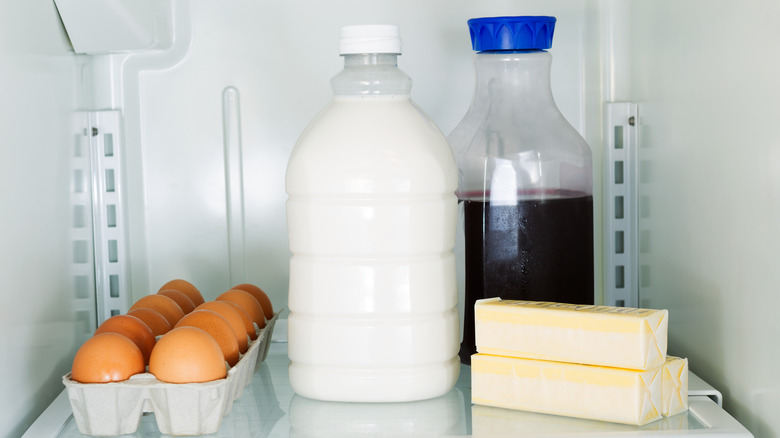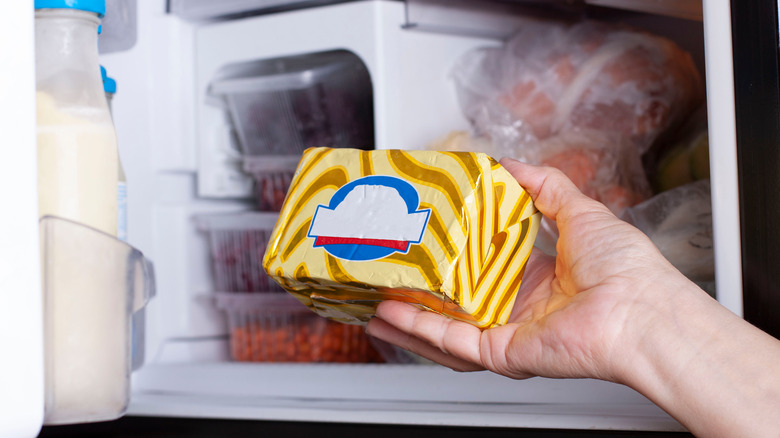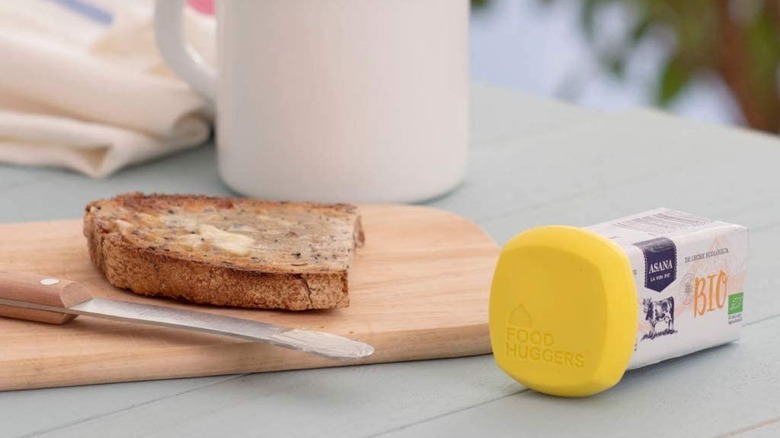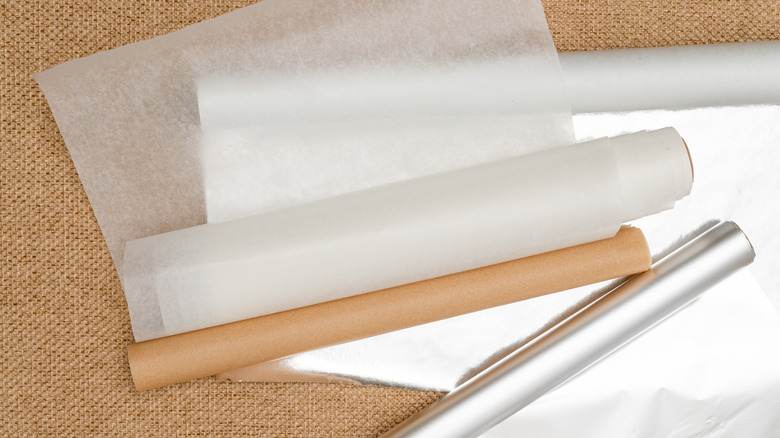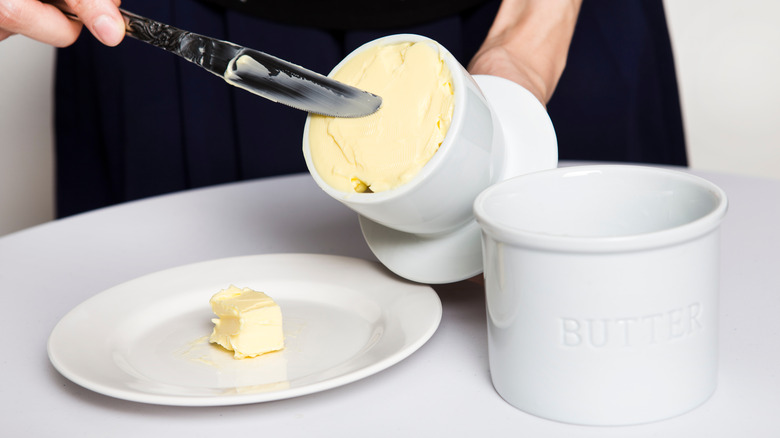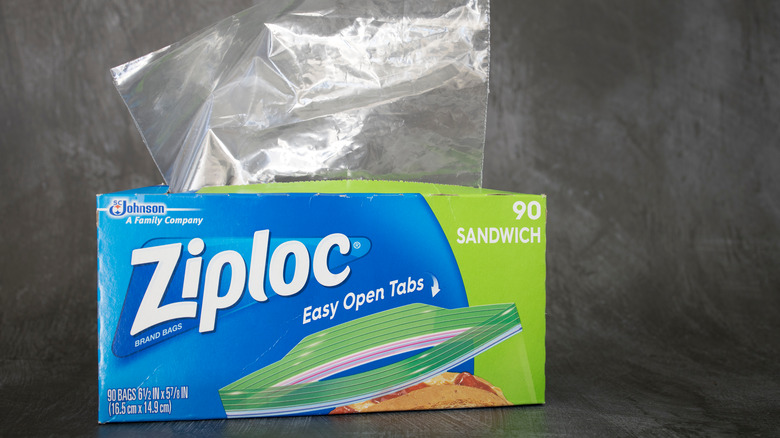13 Best Tips And Tricks For Storing Butter
Butter is one of the world's most time-tested, taste-boosting, tongue-titillating ingredients. From savory to sweet and everything in between, it's deliciously versatile and borderline addictive. With something so useful and awesome tasting, knowing how to store it properly is important. Left to the wrong conditions, butter quickly becomes a hangout spot for bacteria and mold. According to StateFoodSaftey, although butter is classified as a Time/temperature Control for Safety (TCS) food, certain types contain enough fat and salt to be stored at room temperature.
Storing butter properly not only requires being mindful of temperature but also the type of container you use. From stainless steel dishes to ceramic butter bells, like temperature, there are various types of containers suitable for storage. Many have been helping your butter stay fresh for a long time, while others are newer creations. And what's more, whether you enjoy butter creamy and on the counter, or chilling in the fridge, there's a storage container or method that fits your taste. Below is a list of the best tips and tricks for storing that irreplaceable creamy delight called butter.
1. Make sure your butter storage container is clean
It goes without saying that keeping kitchenware clean and sanitized is important. This is especially true for storage containers, the trusty items that safeguard the foods we eat and hope to enjoy as leftovers. Take butter, for example — when improperly stored, its complimentary flavor profile tends to attract and take on the smells of other foods. Fortunately, butter is deliciously versatile and can be stored in a variety of containers and conditions. That's why it's cleaning your butter containers thoroughly is essential to maintaining freshness and avoiding cross-contamination. Unsanitary butter containers can quickly become a cesspool for bacteria growth and should be cleaned out after each finished stick.
Extra special care should be taken of countertop butter storage containers. While it's perfectly okay to store salted butter at room temperature for a few days, if you let it sit for too long, it will inevitably become rancid and unsavory. Even butter that's still good can leave behind leftover bacteria-prone residue if you don't clean between changes. No, really! Make sure you wipe the dish clean of butter and give it a good wash with dish soap before adding another yellow brick. It only takes a second to add time to your butter's shelf life.
2. Keep only salted butter at room temperature
Picture this scene. You've just returned home after a long day's work, and the only thing on your mind is an odd midday craving for buttery pancakes. Your stomach has literally been growling for it all day. On the drive home, you went over the ingredients you needed, mentally checking off boxes. Then after checking the last box, with unshakeable certainty you whizzed by the grocery store. Now in the kitchen brimming with anticipation, you eagerly begin working to make your buttery pancake fantasy a reality. Just as you've nearly gathered everything on your mental checklist, you open the countertop butter container only to find mold growing. Cue the violins.
Storing butter on the counter is a risky affair — there's only a small window to enjoy it, and a single day can mean the difference between a creamy craving and a furry surprise. If you don't have the patience to wait for butter to soften, and you must have it spread-ready around the clock, pasteurized salted butter is the only type you should leave out at room temperature. According to Healthline, salt doesn't provide the best environment for bacteria to flourish. That makes it perfectly okay for storing at room temperature. That said, we also recommend leaving out only small quantities at a time and for no more than a couple days.
3. Refrigerate butter for long-term use
For long-lasting access to flavorful experiences, we recommend storing your butter in the refrigerator. Its chilled confines are the perfect safehouse for keeping butter rancid and spoil-free. Although it doesn't provide the creamy consistency of room temperature, it only takes a few minutes for refrigerated butter to soften once removed. That simply means that room temp storage is better for convenience, but chilled butter is better and more dynamic overall. If patience isn't a virtue of yours, one way to speed up the cooldown is to cut butter into smaller cubes before storing it.
When stored, to protect it from stray aromas and the souring effects of oxygen, butter should always be kept in an airtight container. Ziploc bags and water-sealed butter dishes work great too — just make sure to release the air inside of the Ziploc bag before sealing it. That's how you ensure longer-lasting freshness. If you're wondering whether butter can spoil in the fridge, FoodSafety says that it can last up to two months. That's more than enough time to infuse your everyday life with this flavor-enhancing super ingredient.
Another fun fact that subverts popular belief is where butter should be stored in the fridge. According to the American Butter Institute, rather than storing it inside of the butter container on the refrigerator door, which is the warmest area, it should be kept in the back of the fridge on the middle shelf, which is the coldest area.
4. Store butter in a freezer for longer term use
In addition to the countertop and fridge, butter can also be stored in the freezer for longer-term use. Depending on how well it's stored, you'd be surprised to find that frozen butter can last up to 18 months. That's excellent news for butter lovers and more proof that butter is one of the best foods period.
Speaking of proper storage, there's a debate over which is the best method. To foil or not to foil? That is the question. Food Guys is apparently in favor of the foil and recommends wrapping your butter in it, followed by plastic wrap, before placing it into an airtight container. MasterClass disagrees and asserts that using aluminum foil impacts the fat in butter, causing it to oxidize at a faster rate.
At any rate, a less debatable recommendation is to cut the butter blocks into quarters before wrapping and storing them. As mentioned, smaller cubes are easier to bring to room temperature. Another reason you should freeze your butter is that you can grate it, which also helps it cool down to room temperature faster and is great for baking.
5. Protect open sticks of butter with a silicone cover
Everyone has their own unique method of using a stick of butter. Many of us partially unfold it, take the amount we need, then fold it back up and store it. While effective, eventually it becomes impossible to refold the butter wrapper nicely and neatly. The natural response is to cut off the wrapper, but doing so exposes the butter, presenting another hurdle. Even when you cut only part of the wrapper, it sometimes results in a messy and unsightly storage container.
If you're the type of person that enjoys perfectly curated fridges and kitchen spaces, you'll love the Butter Hugger. It's a patented silicon-based cover for partially consumed sticks of butter. With a straightforward and borderline "Why didn't I think of this?" design, it's the simple and low-cost storage item every butter-lover needs. It literally eliminates the awkwardly refolded wrapper thing we sometimes have a tendency to do. Square-shaped with a small butter-sized compartment, it's perfectly measured to fit around your standard stick.
6. Reduce smell absorption with reusable food wrap
As you know, butter is awesome when paired with other foods. In fact, it has such a complimentary canvas that it not only elevates flavor when added to dishes, its fat even absorbs the smells of foods when stored with them. That's partially the reason why there's a specially-made butter container in every fridge; while not airtight, it helps reduce exposure to the array of flavors from other stored foods. It's far from foolproof, though, and will only provide minor protection without proper wrapping. While we agree that compound butter is amazing, we imagine fridge-flavored butter doesn't quite whet the appetite.
When was the last time you cleaned out your fridge? It's been that long huh? To make sure your butter doesn't catch a case of fridge funk and stays ready at a moment's hunger pang, you should wrap up leftover butter. The easiest way is by using your butter's original wrapping and refolding it tightly after each use. It's an effective method but can sometimes cause a minor mess if done haphazardly. With that in mind, wax paper is a workable alternative, especially for storing home-churned butter, which is at a greater risk of contamination. What's most important is that you seal the wrapper around the butter tightly and securely.
7. Store butter at room temperature longer with a crock
Long before Jacob Perkins got fed up with his food going old and decided to build the world's first refrigerator, butter crocks were a household mainstay for butter storage. Also popularly known as the butter bell, butter keeper, and French butter dish, this fancy invention is hands down the best container for room-temperature storage. With it, butter should last in a countertop crock for several weeks, and in outside temperatures of up to 80 degrees Fahrenheit.
Butter crocks are made of ceramic, and feature a fillable bell-shaped cup, lid, and a basin for water. When using one, you start by filling the bell with pre-softened butter. Next, add water to the basin until it reaches the butter bell stop point, which should be just above the water's surface. The water helps preserve freshness and extends countertop life. The lid of the butter bell should fit perfectly into the basin, sealing it airtight. Take it from us, there's nothing better than having quick and easy access to this creamy condiment.
Two important things to remember are to only use pasteurized salted butter, as unsalted attracts bacteria at room temperature, and to make sure to change the water every few days. The extra bit of maintenance butter bells require is more than worth it.
8. Enjoy clarified butter for six months at room temperature
When butter can't take the heat in the kitchen, clarified butter swoops in to save the day. Clarified butter is the liquid gold-colored cousin that's composed of pure butter fat. Butter is 80% fat, with the remaining 20% being mostly water. Milk solids are produced during the clarification process when milk fat is isolated from the protein and carbs. Removing the milk solids and water found in butter gives it a slightly thicker oil consistency, and you're left with fat that can be used for high-temperature cooking. Along with being able to withstand the fiery Fahrenheits, clarified butter has a really impressive shelf life.
When it comes to storing your clarified butter, if done properly, it can last for up to an astounding six months. Just think of all the amazingly tasty dishes you can whip up in that time. The very thought is probably overwhelming, huh? Clarified butter must be stored in an airtight container — a mason jar works perfectly. Just make sure it's completely dry before filling it because water residue will make it go bad faster. After it's sealed and secure, you can store it in your pantry or on the countertop for easy anytime access.
9. Unpasteurized butter must be stored in the fridge
When storing butter at room temperature, have you found yourself running into the same moldy misadventures over and over again? The biggest mistake you're making is probably the type of butter you're using. The moderate temperatures of countertop storage are strictly reserved for pasteurized salted butter, as it has more sodium, higher fat content, and contains less water. On the other hand, storing unsalted butter is a recipe for rancid because as mentioned, it's classified as a Time/temperature Control for Safety (TCS) food. That basically means it's prone to bacteria growth without proper refrigeration.
All commercially sold butter in the U.S. must be made from pasteurized milk, so unless you're pretty nifty at making it from scratch, you're less likely to experience any problems storing it at room temperature. In other countries where unpasteurized butter is more commonly used, it's important to check the label first. That said, if you happen to leave unsalted butter out overnight, don't worry, as long as it's sealed and airtight, it will last for a few hours at least. The rule of thumb here is easy to remember, unpasteurized butter must always be stored in the fridge.
10. Use a Ziploc bag when storing butter in a cooler
Sometimes your culinary adventures take you on the road, and you have no choice but to pull out and dust off your trusty cooler. Whether for a weekend picnic, or a family-time barbeque, coolers ensure ingredients make it to their destination safely, and that they can be enjoyed fresh and chilled. The tricky part about them is that you're only given a short window before the temperature inside drops to spoil levels. Butter is an especially susceptible ingredient, one that can turn into a liquid mess in an instant.
Portable ice coolers can keep ice chilled from 12 hours to seven days, depending on which type you have and the weather conditions it's in. You can even purchase an iceless electric cooler to make food storage on the go even more convenient. Whether using a regular ice cooler or a powered one, the bottom line is that food should be stored properly. When storing butter in an ice cooler, we recommend using the freezer approach: plastic Ziploc baggies. According to PreparedPantry, if securely wrapped and stored, butter should last at least two weeks in an ice cooler.
You can take it a step further by cutting your sticks of butter into quarters and wrapping each individual cube with plastic wrap before placing them in the Ziploc bag. The wrap will provide an additional layer of protection from stray aromas in the ice cooler, and the degrading effects of oxidation.
11. Wrapping butter in aluminum foil will make it go rancid
This shiny 100% recyclable storing material has been around since 1913 and was originally made for wrapping Life Savers, candy bars, and chewing gum before becoming the staple it is today. Aluminum foil retains its unyielding wrapping powers under any and all conditions — room temperature, in the scorching oven heat, or packed away inside of a frostbitten freezer. It's truly a remarkable invention that's near perfect for its purpose (emphasis on "near perfect").
As mentioned, when you wrap butter in aluminum foil, it increases the oxidation process. In fact, aluminum oxidation is not only a naturally occurring effect of exposure to oxygen, but it's also pivotal to corrosion resistance. Aluminum develops a thin layer of aluminum oxide when it comes into contact with air. That thin layer is why aluminum's resistance to corrosion is so high. It's also why you should never store butter using it.
Oxygen is one of the primary culprits behind butter going rancid, according to a study published in the Annual Review of Food Science and Technology. Through a process called lipid oxidation, foods deteriorate in quality and develop discoloration along with an off-putting smell. While the negative effects of aluminum oxidation are still hotly debated, the science here seems clear enough. That's why we recommend always using wax paper or the original packaging when wrapping and storing butter.

